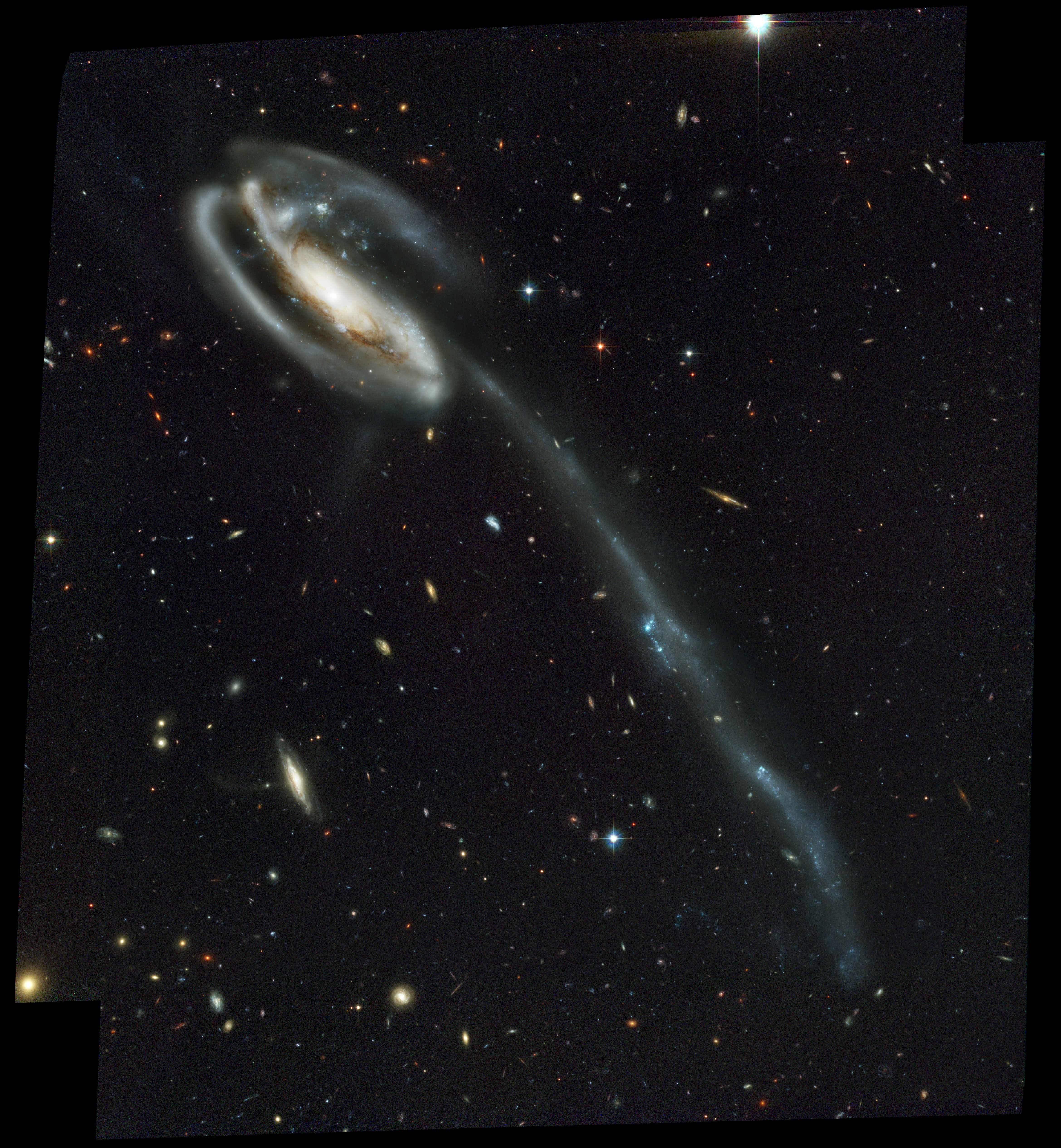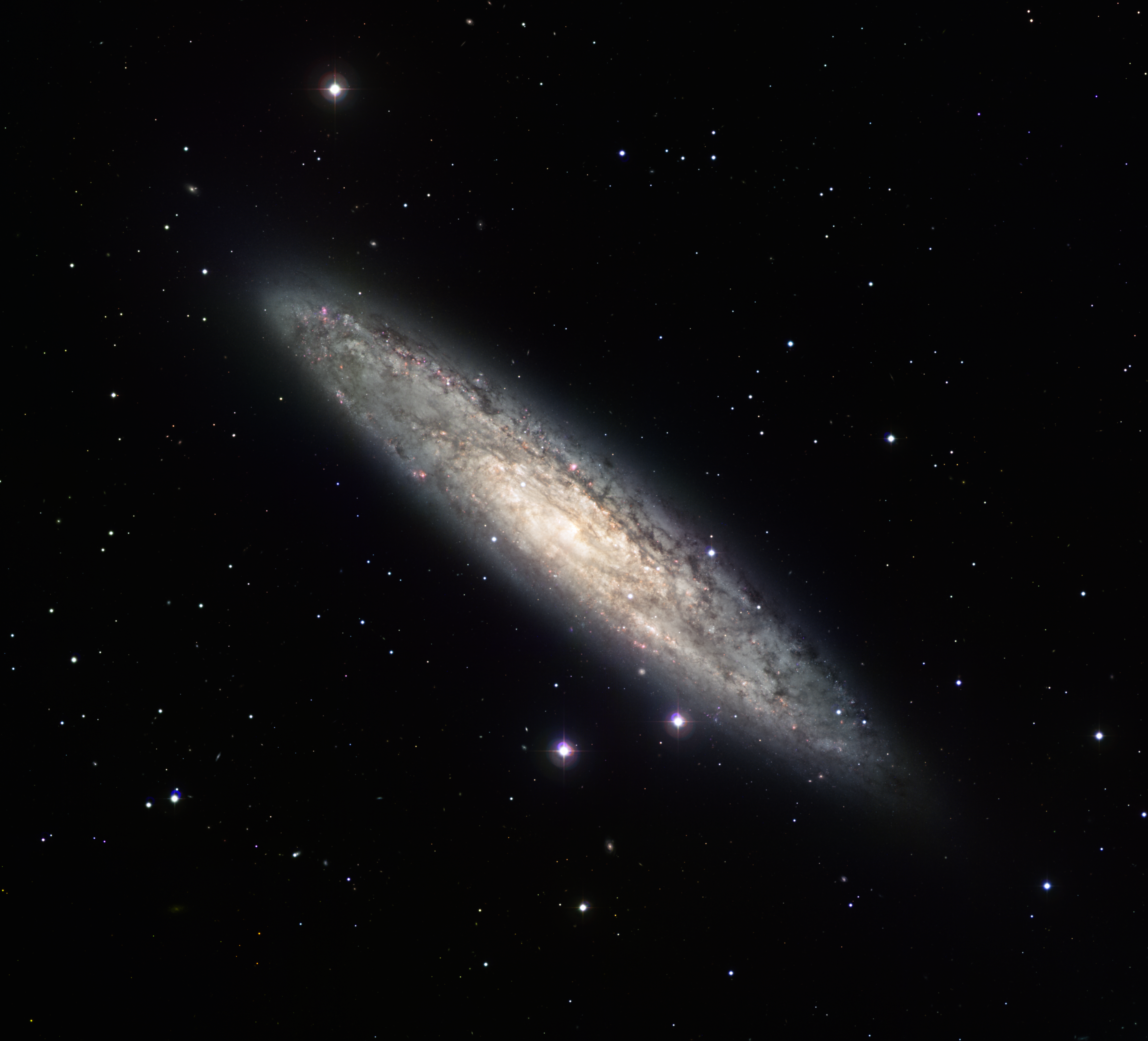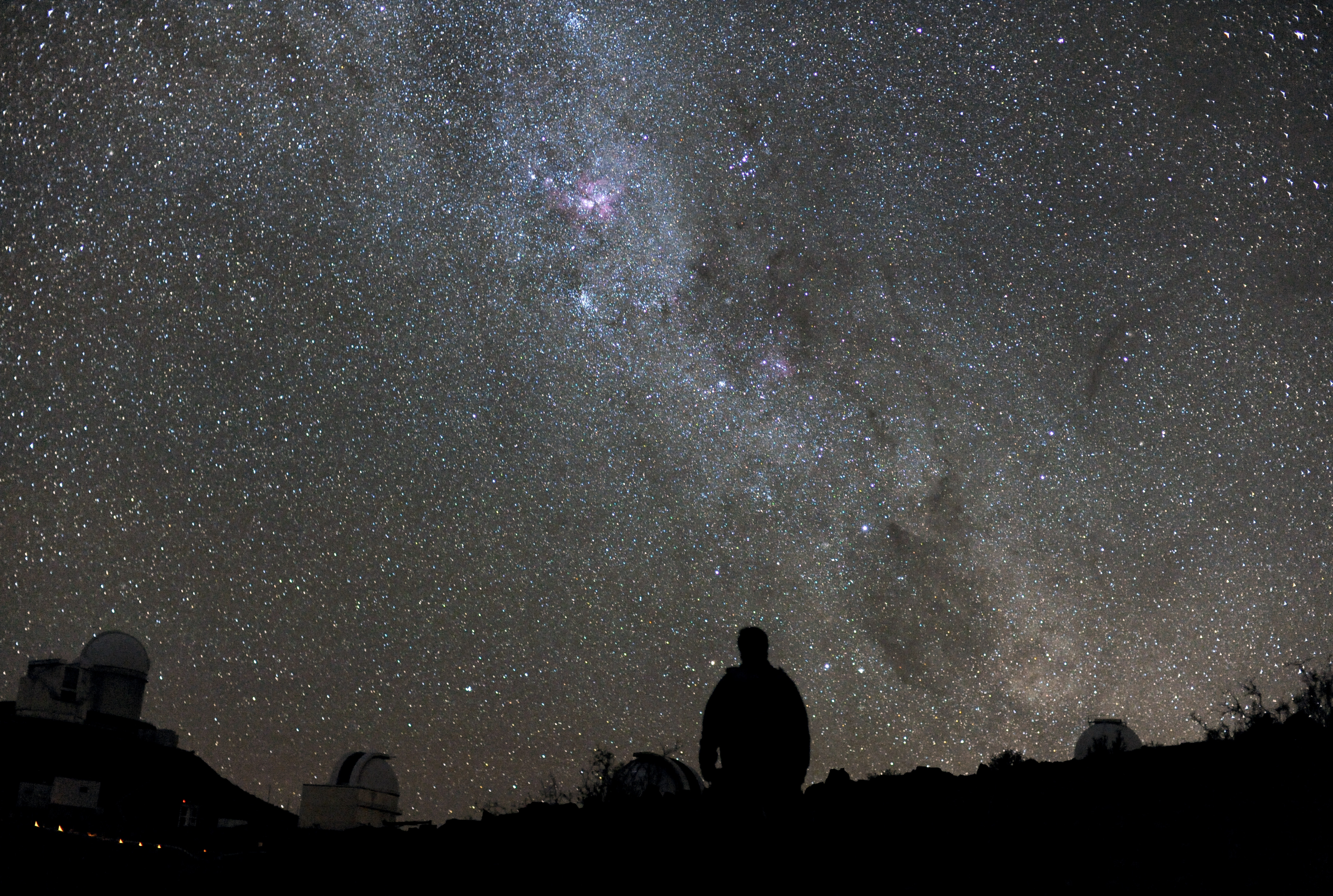|
NGC 7609
NGC 7609 or known as Arp 150 and HCG 95A, is a large elliptical galaxy located in Pegasus. Its speed relative to the cosmic microwave background is 11,879 km/s, which corresponds the galaxy to be located 554 million light-years away from Earth (169.7 Mpc). NGC 7609 was discovered on October 5, 1864, by Albert Marth and included in Halton Arp's, Atlas of Peculiar Galaxies in galaxies that produces jets. With a surface brightness of apparent magnitude 14.59, NGC 7609 is classified as a low surface brightness galaxy (LSB). LSB galaxies are diffuse galaxies with surface brightness that is one less magnitude, of the night sky. A pair of interacting galaxies A SDSS survey image and from the Hubble Space Telescope, showed that NGC 7609 is interacting with nearby galaxy, PGC 71077 (HCG 95C) whose spiral arms is currently being absorbed by the larger entity. A double-nuclei is present in HCG 95C, which is considered a merger remanent of two disk galaxies. Two tidal tails are also ... [...More Info...] [...Related Items...] OR: [Wikipedia] [Google] [Baidu] |
Hubble Space Telescope
The Hubble Space Telescope (HST or Hubble) is a space telescope that was launched into low Earth orbit in 1990 and remains in operation. It was not the Orbiting Solar Observatory, first space telescope, but it is one of the largest and most versatile, renowned as a vital research tool and as a public relations boon for astronomy. The Hubble Space Telescope is named after astronomer Edwin Hubble and is one of NASA's Great Observatories program, Great Observatories. The Space Telescope Science Institute (STScI) selects Hubble's targets and processes the resulting data, while the Goddard Space Flight Center (GSFC) controls the spacecraft. Hubble features a mirror, and its five main instruments observe in the ultraviolet, visible spectrum, visible, and near-infrared regions of the electromagnetic spectrum. Hubble's orbit outside the distortion of atmosphere of Earth, Earth's atmosphere allows it to capture extremely high-resolution images with substantially lower background lig ... [...More Info...] [...Related Items...] OR: [Wikipedia] [Google] [Baidu] |
Earth
Earth is the third planet from the Sun and the only astronomical object known to Planetary habitability, harbor life. This is enabled by Earth being an ocean world, the only one in the Solar System sustaining liquid surface water. Almost all of Earth's water is contained in its global ocean, covering Water distribution on Earth, 70.8% of Earth's crust. The remaining 29.2% of Earth's crust is land, most of which is located in the form of continental landmasses within Earth's land hemisphere. Most of Earth's land is at least somewhat humid and covered by vegetation, while large Ice sheet, sheets of ice at Polar regions of Earth, Earth's polar polar desert, deserts retain more water than Earth's groundwater, lakes, rivers, and Water vapor#In Earth's atmosphere, atmospheric water combined. Earth's crust consists of slowly moving tectonic plates, which interact to produce mountain ranges, volcanoes, and earthquakes. Earth's outer core, Earth has a liquid outer core that generates a ... [...More Info...] [...Related Items...] OR: [Wikipedia] [Google] [Baidu] |
Spectral Line
A spectral line is a weaker or stronger region in an otherwise uniform and continuous spectrum. It may result from emission (electromagnetic radiation), emission or absorption (electromagnetic radiation), absorption of light in a narrow frequency range, compared with the nearby frequencies. Spectral lines are often used to identify atoms and molecules. These "fingerprints" can be compared to the previously collected ones of atoms and molecules, and are thus used to identify the atomic and molecular components of stars and planets, which would otherwise be impossible. Types of line spectra Spectral lines are the result of interaction between a Quantum mechanics, quantum system (usually atoms, but sometimes molecules or atomic nucleus, atomic nuclei) and a single photon. When a photon has about the right amount of photon energy, energy (which is connected to its frequency) to allow a change in the energy state of the system (in the case of an atom this is usually an electron cha ... [...More Info...] [...Related Items...] OR: [Wikipedia] [Google] [Baidu] |
Hydrogen-alpha
Hydrogen-alpha, typically shortened to H-alpha or Hα, is a deep-red visible spectral line of the hydrogen atom with a wavelength of 656.28 nm in air and 656.46 nm in vacuum. It is the first spectral line in the Balmer series and is emitted when an electron falls from a hydrogen atom's third- to second-lowest energy level. H-alpha has applications in astronomy where its emission can be observed from emission nebulae and from features in the Sun's atmosphere, including solar prominences and the chromosphere. Balmer series According to the Bohr model of the atom, electrons exist in quantized energy levels surrounding the atom's nucleus. These energy levels are described by the principal quantum number ''n'' = 1, 2, 3, ... . Electrons may only exist in these states, and may only transit between these states. The set of transitions from ''n'' ≥ 3 to ''n'' = 2 is called the Balmer series and its members are named sequentially by Greek letters: *''n'' = 3 to ''n'' = 2 is ... [...More Info...] [...Related Items...] OR: [Wikipedia] [Google] [Baidu] |
Active Galactic Nucleus
An active galactic nucleus (AGN) is a compact region at the center of a galaxy that emits a significant amount of energy across the electromagnetic spectrum, with characteristics indicating that this luminosity is not produced by the stars. Such excess, non-stellar emissions have been observed in the radio waves, radio, microwave, infrared, visible spectrum, optical, ultra-violet, X-ray and gamma ray wavebands. A galaxy hosting an AGN is called an active galaxy. The non-stellar radiation from an AGN is theorized to result from the accretion (astrophysics), accretion of matter by a supermassive black hole at the center of its host galaxy. Active galactic nuclei are the most luminous persistent sources of electromagnetic radiation in the universe and, as such, can be used as a means of discovering distant objects; their evolution as a function of cosmic time also puts constraints on cosmology, models of the cosmos. The observed characteristics of an AGN depend on several properties s ... [...More Info...] [...Related Items...] OR: [Wikipedia] [Google] [Baidu] |
Tidal Tail
A tidal tail is a thin, elongated region of stars and interstellar gas that extends into space from a galaxy. Tidal tails occur as a result of galactic tide forces between interacting galaxies. Examples of galaxies with tidal tails include the Tadpole Galaxy and the Mice Galaxies. Tidal forces can eject a significant amount of a galaxy's gas into the tail; within the Antennae Galaxies, for example, nearly half of the observed gaseous matter is found within the tail structures. Within those galaxies which have tidal tails, approximately 10% of the galaxy's stellar formation takes place in the tail. Overall, roughly 1% of all stellar formation in the known universe occurs within tidal tails. Some interacting galaxy pairs have two distinct tails, as is the case for the Antennae Galaxies, while other systems have only one tail. Most tidal tails are slightly curved due to the rotation of the host galaxies. Those that are straight may actually be curved but still appear to be straig ... [...More Info...] [...Related Items...] OR: [Wikipedia] [Google] [Baidu] |
Disc Galaxy
A disc galaxy (or disk galaxy) is a galaxy characterized by a galactic disc. This is a flattened circular volume of stars that are mainly orbiting the galactic core in the same plane. These galaxies may or may not include a central non-disc-like region (a galactic bulge). They will typically have an orbiting mass of gas and dust in the same plane as the stars. Interacting galaxy, Interactions with other nearby galaxies can perturb and stretch the galactic disk. Disc galaxy types include: * Spiral galaxy, Spiral galaxies: ** Unbarred spiral galaxy, Unbarred spiral galaxies: (types S, SA) ** Barred spiral galaxy, Barred spiral galaxies: (type SB) ** Intermediate spiral galaxy, Intermediate spiral galaxies: (type SAB) * Lenticular galaxy, Lenticular galaxies: (types E8, S0, SA0, SB0, SAB0) Galaxies that are not disc types include: * Elliptical galaxy, Elliptical galaxies: (type dE) * Irregular galaxy, Irregular galaxies: (type dI) See also * thick disk * thin disk References [...More Info...] [...Related Items...] OR: [Wikipedia] [Google] [Baidu] |
Spiral Arm
Spiral arms are a defining feature of spiral galaxies. They manifest as spiral-shaped regions of enhanced brightness within the galactic disc. Typically, spiral galaxies exhibit two or more spiral arms. The collective configuration of these arms is referred to as the spiral pattern or spiral structure of the galaxy. The appearance of spiral sleeves is quite diverse. Grand design spiral galaxy, Grand design spiral galaxies exhibit a symmetrical and distinct pattern, comprising two spiral arms that extend throughout the galaxy. In contrast, the spiral structure of flocculent galaxies comprises numerous small fragments of arms that are not connected to each other. The appearance of spiral arms varies across the electromagnetic spectrum. In addition to increased brightness, spiral arms are characterised by an increased concentration of interstellar medium, interstellar gas and dust, bright stars and star clusters, active starburst region, starburst, a bluer colour, and an enhanced mag ... [...More Info...] [...Related Items...] OR: [Wikipedia] [Google] [Baidu] |
Night Sky
The night sky is the nighttime appearance of celestial objects like stars, planets, and the Moon, which are visible in a clear sky between sunset and sunrise, when the Sun is below the horizon. Natural light sources in a night sky include moonlight, starlight, and airglow, depending on location and timing. Aurorae light up the skies above the polar circles. Occasionally, a large coronal mass ejection from the Sun or simply high levels of solar wind may extend the phenomenon toward the Equator. The night sky and studies of it have a historical place in both ancient and modern cultures. In the past, for instance, farmers have used the status of the night sky as a calendar to determine when to plant crops. Many cultures have drawn constellations between stars in the sky, using them in association with legends and mythology about their deities. The history of astrology has generally been based on the belief that relationships between heavenly bodies influence or explain events on Ear ... [...More Info...] [...Related Items...] OR: [Wikipedia] [Google] [Baidu] |
Low Surface Brightness Galaxy
A low-surface-brightness galaxy, or LSB galaxy, is a diffuse galaxy with a surface brightness that, when viewed from Earth, is at least one magnitude lower than the ambient night sky. Most LSBs are dwarf galaxies, and most of their baryonic matter is in the form of neutral gaseous hydrogen, rather than stars. They appear to have over 95% of their mass as non-baryonic dark matter. There appears to be little supernova (SN) activity in these galaxies, although LSB galaxy IC 217 hosted 2014cl. Rotation curve measurements indicate an extremely high mass-to-light ratio, meaning that stars and luminous gas contribute only very little to the overall mass balance of an LSB. The centers of LSBs show no large overdensities in stars, unlike e.g. the bulges of normal spiral galaxies. Therefore, they seem to be dark-matter-dominated even in their centers, which makes them excellent laboratories for the study of dark matter. In comparison to the high-surface-brightness galaxies, LSBs are ma ... [...More Info...] [...Related Items...] OR: [Wikipedia] [Google] [Baidu] |
Apparent Magnitude
Apparent magnitude () is a measure of the Irradiance, brightness of a star, astronomical object or other celestial objects like artificial satellites. Its value depends on its intrinsic luminosity, its distance, and any extinction (astronomy), extinction of the object's light caused by interstellar dust along the sightline, line of sight to the observer. Unless stated otherwise, the word ''magnitude'' in astronomy usually refers to a celestial object's apparent magnitude. The magnitude scale likely dates to before the ancient Ancient Greek astronomy#Astronomy in the Greco-Roman and Late Antique eras, Roman astronomer Ptolemy, Claudius Ptolemy, whose Star catalogue, star catalog popularized the system by listing stars from First-magnitude star, 1st magnitude (brightest) to 6th magnitude (dimmest). The modern scale was mathematically defined to closely match this historical system by Norman Robert Pogson, Norman Pogson in 1856. The scale is reverse logarithmic scale, logarithmic: ... [...More Info...] [...Related Items...] OR: [Wikipedia] [Google] [Baidu] |
Surface Brightness
In astronomy, surface brightness (SB) quantifies the apparent brightness or flux density per unit angular area of a spatially extended object such as a galaxy or nebula, or of the night sky background. An object's surface brightness depends on its surface luminosity density, i.e., its luminosity emitted per unit surface area. In visible and infrared astronomy, surface brightness is often quoted on a magnitude scale, in magnitudes per square arcsecond (MPSAS) in a particular filter band or photometric system. Measurement of the surface brightnesses of celestial objects is called surface photometry. General description The total magnitude is a measure of the brightness of an extended object such as a nebula, cluster, galaxy or comet. It can be obtained by summing up the luminosity over the area of the object. Alternatively, a photometer can be used by applying apertures or slits of different sizes of diameter. The background light is then subtracted from the measurement to obt ... [...More Info...] [...Related Items...] OR: [Wikipedia] [Google] [Baidu] |









